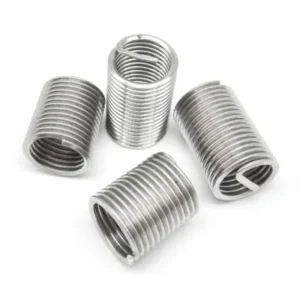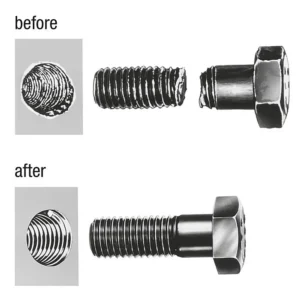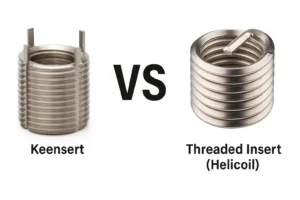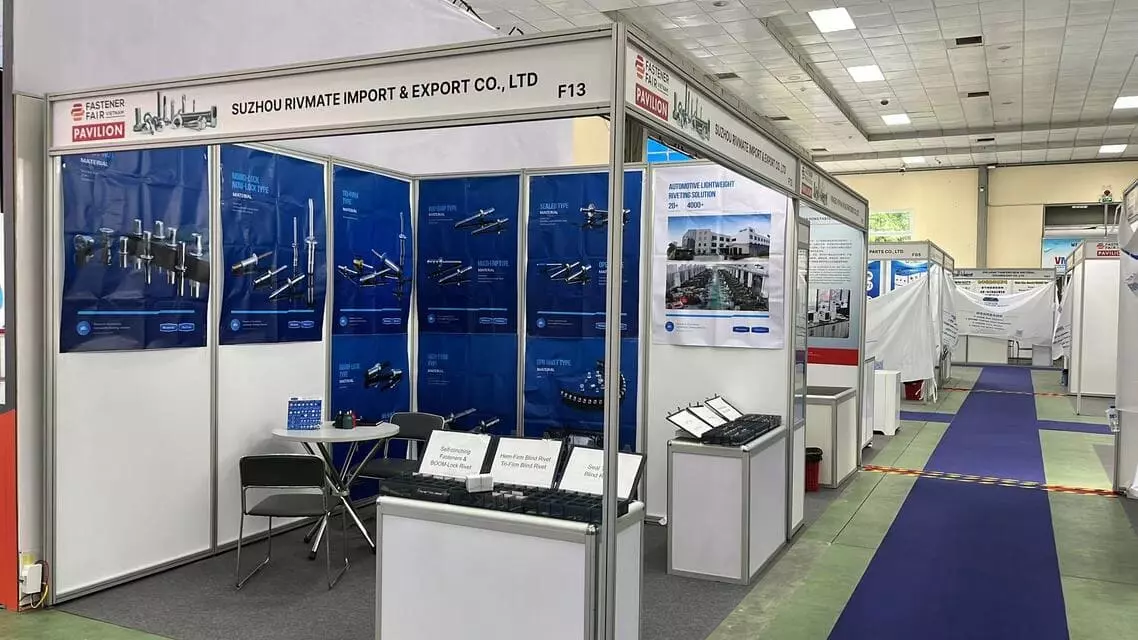How To Choose Threaded Inserts for Plywood?
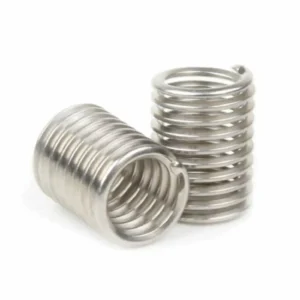
Leading Threaded Inserts Manufacturer and Supplier in China
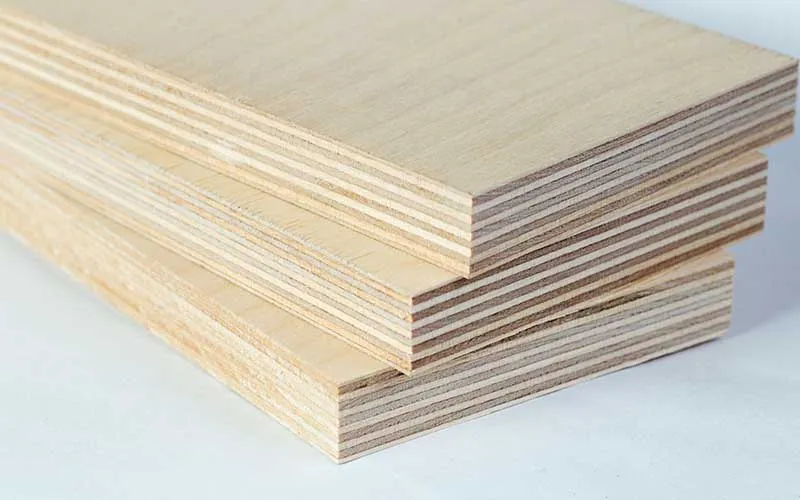
When using wood screws directly in plywood structures, two issues often arise: insufficient thread engagement force and thread failure after repeated assembly and disassembly. This is because plywood is made by cross-laminating multiple layers of wood veneer, which although it has a certain degree of strength and stability, its interlayer structure lacks the thread-bearing capacity of solid wood, especially in the transverse direction where delamination or cracking is more likely to occur. In such cases, threaded inserts can serve as enhanced connection interfaces, offering the following advantages:
- Enhanced thread strength and durability: The inserts are embedded into the plywood via external threads or structural locking mechanisms, effectively distributing stress and preventing localized wood fractures;
- Suitable for structures requiring repeated assembly: such as furniture, industrial fixtures, and disassemblable wooden components, the inserts provide stable internal threads to prevent stripping;
- Improve overall structural precision and reliability: especially in load-bearing or vibrating areas, they prevent screw loosening and enhance long-term connection stability;
- Support standard fastener installation: using standard mechanical screws enhances assembly versatility and maintenance convenience.
Table of Contents
What Types of Threaded Inserts Work Best in Plywood?
① Self-Tapping Inserts
Structural Principle: Features a wide and deep external thread design (typically coarse-threaded or knife-edge type), enabling direct “cutting” or pressing into the fibers of the panel material;
Suitable Plywood Types: Medium to high-density structural plywood, birch plywood, composite panels;
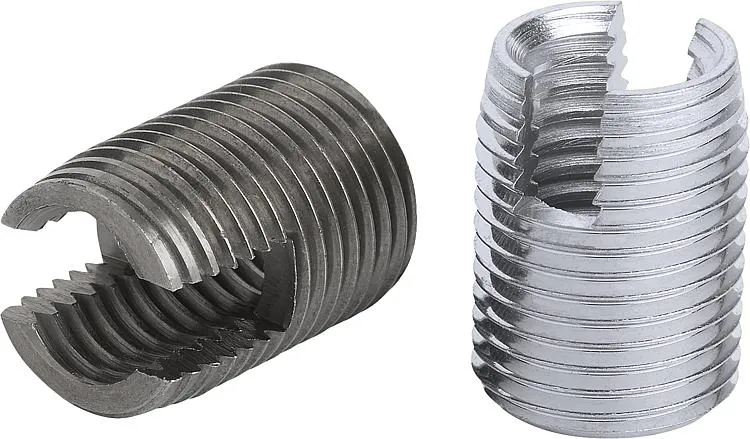
Performance Characteristics:
- Consistent pull-out resistance (M6 threads can achieve 600–900 N in 12 mm thick panels);
- No adhesive required for installation, but weak adhesive may be used to enhance initial positioning strength;
Recommended Usage:
- The pre-drilled hole diameter should be 0.5–1.0 mm smaller than the outer diameter (depending on thread pitch and panel density);
- Manually screw in using a hex wrench or an installation rod with a stop function;
- Avoid repeated back-and-forth movements during screwing to prevent “thread stripping” or panel splitting.
② Press-In Inserts
Structural Principle: Typically features serrated edges, conical teeth, or knurled patterns on the outer surface, which mechanically lock into wooden fibers through pressure;
Suitable Plywood Types: Dense-layered plywood such as E0-grade birch plywood and pine plywood;
Performance Characteristics:
- No spiral stress after installation, suitable for high-density panels prone to cracking;
- Simple installation process, suitable for mass assembly production;
Usage Tips:
- Can be installed using mechanical pressing or manual vise clamping;
- It is recommended to use specialized positioning fixtures to ensure vertical insertion and prevent eccentricity;
- Pre-drilled holes must be precise, with a recommended tolerance of ±0.05 mm, and surface flatness must be controlled within ±0.1 mm.
③ Heat-Set Inserts

Structural Principle: Using heating equipment (soldering iron or hot press) to heat the insert to approximately 180–220°C, causing it to melt into the surface layer and solidify upon cooling;
Suitable Plywood Types: PVC-coated plywood, WPC wood-plastic composite panels, PU-coated panels;
Advantages:
- Forms a uniform fused layer after installation, ensuring secure and stable fixation;
- Surface is less prone to cracking, suitable for decorative or exterior components;
Usage Notes:
- Temperature control is critical; excessive heat may cause surrounding areas to delaminate or bubble;
- The insertion time for inserts must be controlled within 2–5 seconds to prevent localized burning;
- Not recommended for use on all-wood plywood due to significant differences in thermal expansion coefficients, which may cause instability.
④ Brass Inserts with External Thread
Structural Principle: Brass material has high plasticity and strength, often with spiral or straight external threads, which can be inserted into plywood by screwing or light pressure;
Suitable Plywood Types: Solid wood plywood, decorative plywood, and furniture-grade base materials;
Functional Performance:
- Standard internal threads (M4–M8) compatible with conventional screws;
- Smooth surface suitable for decorative or visible components;
Usage Recommendations:
- Pre-drilling is required to match the thread pitch specification when screwing in;
- If used in load-bearing structures, use a locking adhesive (such as Loctite 243) to prevent loosening;
- Not recommended for use in high-humidity environments without protection; opt for nickel-plated materials to enhance corrosion resistance.
⑤ Threaded Inserts with Dual External Threads

Structural Features: Features dual-level external threads or a flange design, allowing insertion from the front and securing with a nut from the back to form a clamping lock;
Suitable Plywood Types: Multi-layer structural panels, heavy-duty panels with a thickness of ≥12mm;
Advantages:
- Suitable for vibration-resistant connections, such as wall-mounted systems and industrial fixtures;
- High shear strength, with shear force up to 1000 N or more (M6 specification);
Assembly Requirements:
- Must be accessible from both sides;
- The rear clamping plate must have sufficient contact area to prevent deformation;
- Optional anti-loosening washers can be added to enhance anti-loosening performance.
Table: Choose Threaded Inserts for Plywood
| Type | Installation Method | Tensile Strength | Suitable for Repeated Assembly | Recommended Applications |
|---|---|---|---|---|
| Self-tapping | Screw-in | Medium-high | ✅ | Furniture, DIY woodworking structures |
| Press-in | Press-fit | Medium | ❌ (suitable for one-time use) | Finished panels, display panels, home accessories |
| Hot-melt | Heating | Medium | ✅ | Plastic-wood composite panels, decorative plywood |
| Brass external threaded insert | Screw-in/Press-fit | Medium-high | ✅ | High-end furniture, speakers, decorative structures |
| Double external threaded steel sleeve | Back-locking | High | ✅ | Hanging components, mechanical motion connection points |
How Does Plywood Differ from Solid Wood in Fastener Design?


1. Plywood has a multi-layer interlocking structure with discontinuous fibers
Plywood is made by gluing together an odd number of veneer layers (typically 3–13 layers) in a crisscross pattern, with the fiber directions alternating between layers. This gives the plywood overall dimensional stability and minimal deformation, but also results in discontinuous thread engagement paths. This means:
- Screws cannot form a stable long-pitch engagement when driven in;
- Discontinuous fibers cause uneven force distribution on external threads, leading to “thread stripping” or slippage;
- If standard wood screws are used, connection strength can be reduced by 30–50% compared to solid wood.
2. Significant differences in pull-out strength
At the same thickness, plywood has lower pull-out resistance to screws than solid wood with a dense grain direction. For example:
- M6 wood screws have a pull-out resistance of approximately 1000–1200 N in 18mm rubberwood;
- The same specification in 18mm E1-grade pine plywood has only approximately 500–700 N;
- If repeatedly disassembled and reassembled, the fibers of plywood tend to “fuzz up,” causing the screw holes to gradually fail.
Therefore, plywood is more suitable for use with self-tapping threaded inserts or press-fit sleeves, which utilize external thread structures to achieve broad-surface engagement.
3. Interlayer delamination risk requires control of installation stress
Since the adhesive layer is a brittle structure, excessive installation torque or unreasonable thread design can easily cause interlayer separation or implosion, specifically manifested as:
- Surface blistering and delamination cracking;
- Uneven compression of elastic washers, affecting overall flatness;
- Resonance displacement in sound equipment structures.
Countermeasures include:
- Controlling insertion depth and axial pressure (recommended ≤ 200 N·cm);
- Using dual pitch design or conical tooth structures to distribute pressure;
- Applying localized adhesive (e.g., epoxy + sawdust) to enhance holding force.
4. Plywood is suitable for repeated assembly but requires the selection of appropriate inserts
If the structure involves repeated disassembly (e.g., furniture, multimedia racks, chassis housings), direct use of wood screws will lead to rapid failure, while inserts provide:
- Stable threaded interfaces capable of withstanding over 300 repeated twists (brass inserts are typical);
- Higher wear resistance and dimensional stability;
- Compatibility with standard M-series screws, enabling universal assembly with other components.
Summary Recommendations:
| Feature Comparison | Solid Wood | Plywood |
|---|---|---|
| Fiber Continuity | High, consistent grain | Moderate, interlayer interlocking |
| Pull-out Strength | High, suitable for direct threaded screw connections | Low, recommended to use insert-locking structures |
| Interlayer Peeling Risk | Low | Moderate to high, requires control of installation stress |
| Repeated Assembly Performance | Poor, prone to stripping | Moderate, significantly improved with inserts |
How Can You Ensure Durable Connections in Plywood?
Structural Selection Recommendations: Matching Inserts to Plywood Characteristics
- Optimal Insert Types: Use self-tapping, knurled press-in, or threaded keyway-type inserts with self-locking structures to enhance resistance to rotation;
- Precise Control of Pre-drilled Hole Dimensions: The pre-drilled hole diameter must match the insert’s outer diameter and the plywood’s density; the depth should be slightly greater than the insert’s length by 0.5–1.0 mm;
- Avoid Edge Splitting Risks: The edge margin of the insert should be ≥ 1.5 times the board thickness to avoid using standard inserts near the edge;
- Enhance Structural Stability: For structures subjected to pulling or impact loads, locally install metal washers, backing plates, or internal rings.
Installation Control Points: Enhancing Durability and Resistance to Loosening
- Control torque and axial pressure: Use torque-limiting tools or spring washers to prevent over-tightening damage to the plate or rotation and loosening of the insert;
- Increase vibration resistance measures: Use anti-loosening adhesive, nylon lock nuts, or flange screws in dynamic structures to enhance joint stability;
- Repeat Assembly with Anti-Slip Threads: It is recommended to use brass or stainless steel inserts to improve thread wear resistance and reuse frequency;
- Protect Finished Surfaces: Use positioning fixtures before pressing or screwing in to avoid embossing, eccentricity, or scratching the finished surface layer.
Where Are Threaded Inserts Most Commonly Used in Plywood Applications?
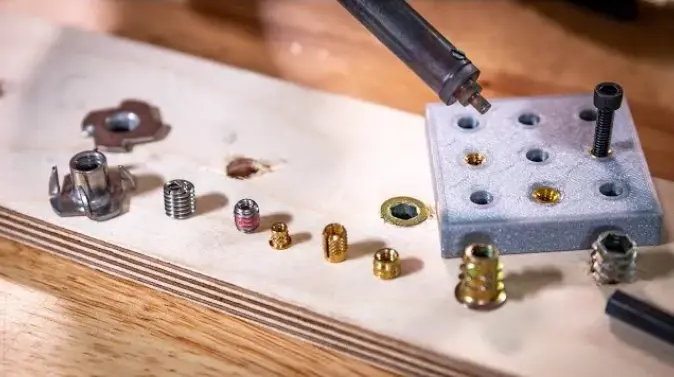
Furniture manufacturing (such as bed frames, cabinet bodies, and tabletops)
In furniture structures, especially at connection points that require weight-bearing capacity or repeated assembly/disassembly, such as bed panels and supports, or table legs and tabletop interfaces, using self-tapping brass inserts or press-fit steel inserts can significantly enhance thread strength and prevent thread stripping or loosening caused by wood fatigue. When used with flange screws, they also improve vibration resistance and overall durability.
Custom cabinets and decorative structures
Cabinet hinges, shelf supports, and built-in appliance installations require long-term stable and aesthetically pleasing connections. For such structures, hot-melt or press-fit brass inserts are recommended, as they not only enhance structural strength but also protect surface finishes from tearing, making them suitable for high-end custom cabinets or decorative panel projects.
Display Stands / Commercial Display Cabinets
In retail or exhibition environments, display stands and cabinets are frequently moved and disassembled. Such structures require quick assembly, high load-bearing capacity, and good reusability. We recommend using M6–M8 press-fit steel inserts with anti-rotation structures to achieve efficient and stable installation, compatible with standardized modular designs.
Woodworking DIY and Small-Scale Production
For personal woodworking projects or small businesses producing prototypes, jigs, and fixtures, users typically seek reusable threaded interfaces with a clean appearance. We recommend precision self-tapping inserts, paired with torque-limiting tools and positioning fixtures, to enhance connection accuracy and reduce assembly errors.
Material Selection: Brass, Zinc Alloy, Steel – What’s Best?
1. Brass Inserts
Advantages:
- Excellent corrosion resistance, suitable for conventional indoor and neutral humidity environments;
- High processing precision, compatible with multiple installation methods such as hot melt, ultrasonic, and self-tapping;
- Flexible material with strong fiber-gripping capability, less likely to split plywood.
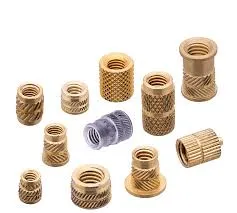
Typical Pull-Out Strength:
M6 inserts can achieve 500–900 N (depending on panel thickness and structure).
Applications:
Furniture connections, 3C enclosures, and light-duty equipment installations.
Cost:
Moderately high, suitable for applications requiring high structural stability and aesthetic appeal.
2. Zinc Alloy Inserts
Advantages:
- Lowest cost, suitable for high-volume, low-load applications;
- Easy to die-cast, high adaptability, suitable for temporary assemblies.
Disadvantages:
- Average corrosion resistance, prone to corrosion spots in high-humidity or acidic environments;
- Low load-bearing capacity, shear/pull-out strength typically only 60–70% of brass.
Applications:
Disposable structures, simple partitions, non-structural component assemblies.
Cost:
Lowest, suitable for cost-sensitive products.
3. Steel Inserts
Advantages:
- Highest strength, suitable for high loads and frequent disassembly and assembly;
- Stainless steel versions have excellent corrosion resistance and can be used in humid or industrial environments;
- Suitable for precision positioning assemblies, such as industrial jigs and fixtures.
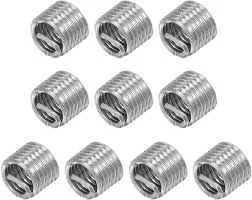
Disadvantages:
- Heavier weight, slightly higher processing and installation difficulty;
- Highest cost among the three options.
Applications:
Vibrating equipment, lifting components, heavy-duty woodworking structures.
Typical Performance:
M6 stainless steel inserts have a pull-out strength of >1000 N and a shear strength of >1500 N.
Table: Material Performance Comparison Table
| Material | Corrosion Resistance | Pull-out Strength Performance | Cost Grade | Recommended Applications |
|---|---|---|---|---|
| Brass | ★★★★☆ | ★★★★☆ | ★★★☆☆ | Furniture, appliances, general DIY |
| Zinc alloy | ★★☆☆☆ | ★★☆☆☆ | ★☆☆☆☆ | Low-load applications, temporary structures |
| Stainless steel | ★★★★★ | ★★★★★ | ★★★★★ | Heavy-duty connections, industrial fixtures, high-humidity environments |
Selection Recommendations Summary:
- If you prioritize stability and corrosion resistance lifespan, brass inserts are the preferred choice;
- If the project is cost-driven with low load requirements, zinc alloy can significantly reduce costs;
- If used in high-load or high-frequency loading/unloading structures, stainless steel inserts are the only reliable option.
Comparison Table: Insert Types vs. Performance in Plywood
| Insert Type | Installation Method | Recommended Board Thickness | Pull-out Resistance (N) | Cost Grade |
|---|---|---|---|---|
| Self-tapping brass insert | Screw-in installation | ≥12mm | 500–900 | Medium |
| Press-in steel insert | Mechanical press-fit | ≥10mm | 700–1200 | High |
| Heat-melt type insert (brass) | Heated insertion | ≥8mm | 400–800 | Medium |
| Zinc alloy self-tapping inserts | Manual insertion | ≥10mm | 300–500 | Low |
| Stainless steel inserts (thick-walled) | Press-fit or pre-installed with structural adhesive | ≥15mm | >1000 | High |
FAQ: Threaded Inserts for Plywood
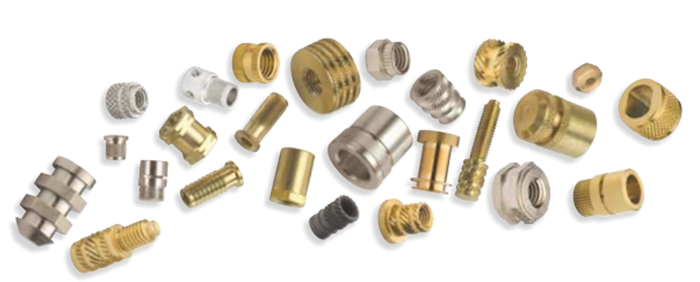
①. Are hot melt inserts suitable for plywood?
Generally not recommended. Hot melt inserts require heating to melt the metal into the plastic base material, but plywood is a laminated structure containing multiple layers of adhesive and veneer, which does not provide the conditions necessary for hot melt plasticization. Heating may instead cause delamination, charring, or structural deformation. If a similar process is required, it is recommended to switch to preheated + press-in inserts or directly use self-tapping brass inserts.
② How can I prevent screws from penetrating plywood?
- Strictly control screw length: recommended screw length ≤ board thickness – 1 mm gap from the bottom of the insert;
- Use inserts with limiting shoulders or internal depth-limiting structures;
- Calibrate the pre-drilled hole depth before installation to avoid wood tearing caused by floating installation;
- For thin panels with a thickness <12mm, it is recommended to use short-threaded inserts with flanged head screws to provide a larger contact area.
③ Will repeated disassembly and reassembly damage the internal structure of plywood?
No, provided that appropriate material and structure inserts are selected. We recommend using brass self-tapping or knurled press-in inserts, whose internal threads do not wear out with screw use and offer good structural stability. In actual use, high-quality inserts can withstand 200–500 repeated assemblies without loosening, making them suitable for modular furniture or industrial structures.
④ What should be done if the insert falls out or becomes loose due to rotation?
- Check if the pre-drilled holes are too large or the insertion force is insufficient;
- If the board material is locally deteriorated, use structural adhesive (such as AB adhesive) + secondary reinforcement of the insert;
- For minor rotational loosening, apply threadlocker (e.g., Loctite 243) and use flange screws for additional pressure-locking;
- If structurally feasible, reinforce the area by thickening it or replace with steel inserts to enhance clamping force.
⑤ Can inserts be installed on the edges of plywood?
Yes, but special attention must be paid to edge distance control and explosion-proof edge treatment. Generally, the edge distance of the insert should be ≥ 1.5 times the board thickness. For example, the edge distance for 18mm plywood should be ≥ 27mm. If space is limited, use small-sized inserts + recessed embedded structures or add shims to prevent edge cracking.
Conclusion: Choosing the Right Insert For Plywood
Selecting the right threaded insert for plywood structures not only significantly improves connection strength and reusability, but is also a key factor in ensuring product quality and assembly efficiency. When selecting an insert, it is important to consider the thickness of the board, load requirements, installation method, and environmental conditions, and to choose the appropriate type, structure, and material of the insert.
It is recommended to prioritize the use of self-tapping brass inserts or press-fit steel inserts, combined with pre-drilled hole size control and torque management to ensure installation reliability. For projects involving special applications, bulk automation, or high-strength structures, it is advisable to contact the professional technical support team in advance to obtain customized insert solutions and testing parameter recommendations. Proper selection is the starting point for product performance and brand trust.
Do You Have Any Questions?
Let Us Solve Your Problem
Why Choose Rivetfix Threaded Inserts for Plywood?
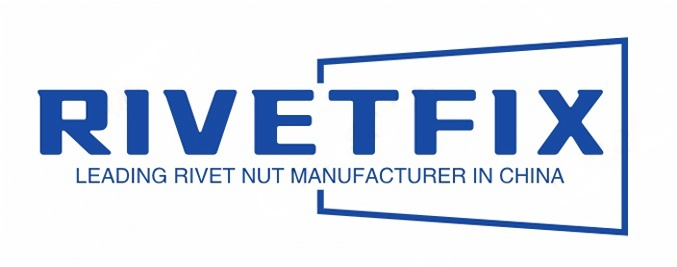
Choosing Rivetfix as your threaded inserts supplier for plywood projects means you will enjoy the multiple advantages of professional customization, high-quality assurance, and reliable delivery times.
- Rivetfix possesses extensive customization capabilities. Whether it’s dimensions, material selection, or surface treatment, we tailor solutions to meet customer requirements, ensuring that the rivet nuts perfectly match the plywood and its application environment, providing optimal connection strength and durability.
- Quality control is Rivetfix’s core competitive advantage. We strictly adhere to the ISO quality management system, rigorously monitoring every step from raw material procurement to final product inspection to ensure that every rivet nut meets international standards and customer requirements, delivering consistent reliability.
- Additionally, Rivetfix possesses robust global supply chain management capabilities, enabling swift response to order demands, stable delivery, and support for timely project completion, thereby mitigating any supply risks.
Choosing Rivetfix means choosing professional, customized rivet nut solutions to optimize your plywood connection projects, achieving higher production efficiency and product quality. Please contact us for more product details and customized services.
Get High Quality Rivet Nuts Quote!
Send Your Rivet Nut Request
For more than 20 years, Rivetfix has helped customers solve many rivet nuts sourcing needs and technical challenges.
Have a question? Contact us and we’ll provide you with the perfect solution.

